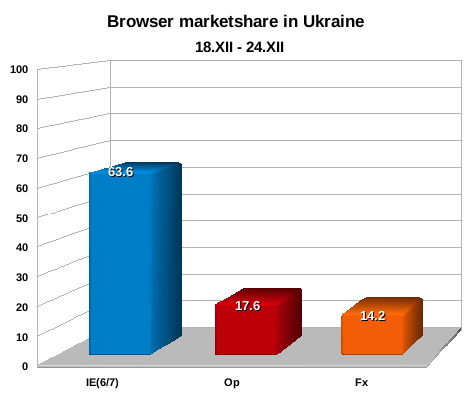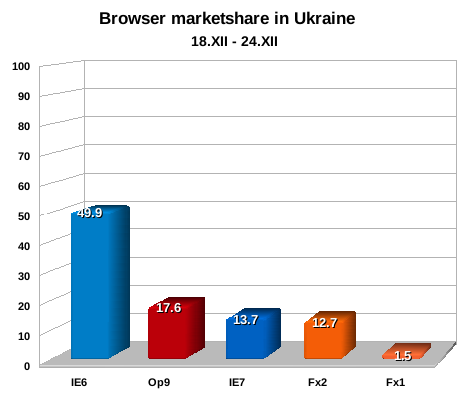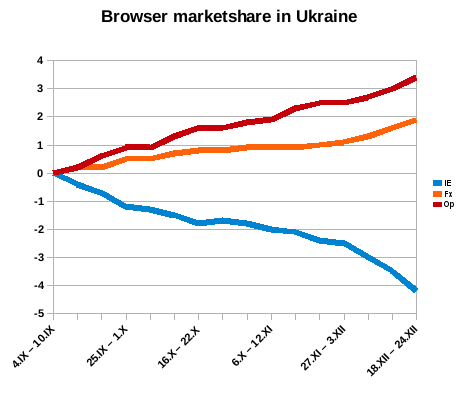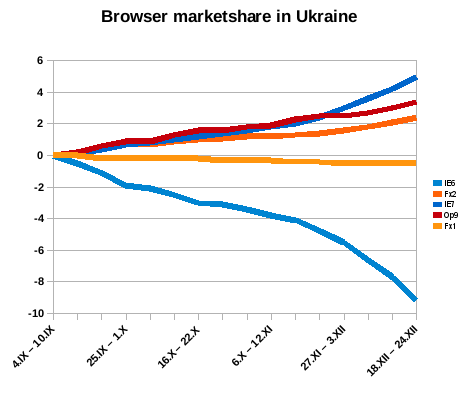The fifth part of this summary focuses on Ukraine. (part 1 – Poland, part 2 – Czech Republic, part 3 – Hungary, part 4 – Lithuania)
Population: 46.8 mln
Internet users: 5.3 mln (11.5%)
Ukraine, in contrast to previously described Lithuania, is the biggest of the countries from the group I’m describing now. It’s also the only country that is bilingual. Its situation is so different to other countries that I’ll spend more time describing it before we’ll skip to browsers. Feel free to ignore that part, but you may end up asking yourself why Firefox adoption is so low here.
While, in fact, the only official language of Ukraine is Ukrainian, over 17.3% of the population of Ukraine are Russians. In result, 24% of the population speaks native Russian. Another important factor is a strong demographic difference between the East of Ukraine and the West. The western part of Ukraine is focused on partnership with the European Union, while the eastern part looks at Russia as their strategic partner and there is a strong animosity between them. In result for many Ukrainians, Russian language has strong negative correlation. Of course, such model is oversimplified, but it can make it easier for the reader to understand the complexity of the internal situation in Ukraine. Another interesting factor is that although Ukraine is a poor country by European standards (position 100th on the list of GDP per capita), it produces the fourth biggest number of tertiary graduates in Europe.
Speaking about Gemius numbers, I have to remind you that comparing to other countries from the group, data from Ukraine is a smallest probe with around 400 000 users tracked out of 5.3 mln users of the Internet overall. Yet, I believe that the results are representative for the country’s situation.
I have also three other sources from Ukraine that confirm the results presented below, and it also matches the latest results from XiTi Monitor.
Another important factor is that the 53% of the tracked page hits were from the Kyiv region where the capital of the country is located. It’s to be expected since the Internet connection is very much limited and as you have seen above, only 11.5% of the population uses Internet at all.
Because one of the key factors of the low Internet usage rate are the connection prices, we should expect that the tracked group is richer than average, better educated, with better machines etc. -> if someone can afford Internet connection, he probably can afford a good monitor.
And gemius data confirms that. While the average group of 1280×1024 users in Poland, Czech Rep., Hungary and Lithuania is 18.4%, in Ukrainian group it is 31.9%.
The OS situation is that the market share of Windows Vista is the lowest (of of the group) with just 2.4% while the Linux is the highest (0.6% of the market share comparing to average 0.4%).
So how does the situation look like when it comes down to browser market share?
Totally different!
The highest IE market share – over 63.6%, the lowest for Firefox – just 14.2% and huge market share of Opera browser – 17.6%.
Together, Firefox and Opera have less market share here than Firefox alone in Poland or Hungary!
It looks even worse for Firefox when we split IE to IE7 and IE6:
Fortunately, IE6 is below 50% mark but it’s the strongest IE6 position of the group. Together with the strongest Opera presence (Opera has more market share in Ukraine that in 4 other countries together!) and Firefox owning 15% less than the average, Ukraine is probably one of the most intriguing countries to analyze.
Now, let me give you my explanation of this.
Do you remember which other country has a higher IE7 market share than Firefox’s one? Yes. Lithuania.
And as you may remember from my previous post, Lithuania got Firefox localized 1.5 year after Fx 1.0 release. How does it look for Ukraine?
The very first release of Firefox in Ukrainian happened on November 26th 2007. Less than two months ago! Three years after Firefox 1.0 release!
So we have now 3 countries where Firefox 1.0 was released in local language (Poland, Czech Republic, Hungary), a country where Firefox has been released in local language 1,5 year later, and a country where it has been released another 1,5 year later.
What conclusions can we draw from this correlation from Lithuania and Ukraine?
- It seems that Firefox has been released in the perfect moment. Users were tired of IE and were ready to switch. If not to Firefox, they would have started switching to Opera.
- Firefox is clearly winning wherever it can be offered in local language
- Localization matters a lot in case of Central Europe (we cannot give lack of localization as the reason for poor Fx adoption in Netherlands and United Kingdom)
- Opera is a browser that can take bigger than 5-6% market share when Firefox is not available.
- Users are switching to IE7 more often, when Opera is an alternative instead of Firefox (compare Vista and IE7 market share in Ukraine), so Firefox is a better competitor when rivaling IE7.
- Firefox 2 can grab around 13% of the market share without a localization in the country where English language is not too popular
Let’s take a look at the last 16 weeks and how it has been changing during the timeframe.
During the last 16 weeks, Opera has been gathering market share faster than Firefox. And in result gathered additional 3.4%, while Firefox gained only 1.9%.
This is another chart that looks differently for Ukraine. Opera is on the highroad and is the number one choice for users abandoning blue E. Firefox is not only in a worse position, but it’s also progressing slower.
Another important thing is that, as I wrote in the beginning, 24% of Ukrainians speak Russian as their native language, and almost everyone understands Russian. It means that many Firefox users from Ukraine may be using Russian locale.
So it’s possible that the importance of localization is even higher than these numbers show.
If we split it into versions, we can see IE7 taking a lead, Opera second and Firefox third.
The good news is that it’s gaining users now, because one year ago, during January 2007, Firefox even dropped from 8.7% to 8.1% of the market share in Ukraine.
At the same time, January 2007, Opera had 10.1% of the market share. Currently, Opera 9 has 17.6% and Opera 8 – 1.3% which gives 18.9% totally for 24th of December. (next two weeks bumped Opera to 22.7% this week, but this may be a peak caused by holiday season, we’ll see).
The last chart is a week to week one.
What we can see is a totally different picture to similar graphs from Poland, Hungary, Czech Republic or Lithuania.
During the last 16 weeks there was no clear line trend, and Firefox is currently gaining approximately just below 0.2% per week, while 16 weeks ago it was gaining just below 0.04% per week. At the same time Opera went up from average 0.2% per week to 0.25%.
It means that even now Opera is gaining users faster than Firefox, and while it’s pretty probable that after some time Firefox will reclaim the number two position in Ukraine, Opera is not slowing down yet just because Firefox appeared.
It’s a very interesting case to watch. What will happen? Will Opera keep its trend because of viral marketing of its users? Will Firefox normalize the situation and next year trends will look similar to other countries from this region?
Will this case confirm Lithuanian case that Firefox is a preferred choice once available over Opera or will it show that once Opera has a chance to gather big market share it can compete with Firefox well?
Will strong position of Opera and Firefox result in lower IE usage and better web standards support on the market? What can we learn from the Ukrainian case about the market share situation?
No matter what will happen, I’d like to congratulate and thank the Ukrainian localization team, for their hard work that will make the free open source browser of choice of so many million people available to Ukrainians offering the best experience possible.
I’d like to give credits to Benjamin Smedberg who was leading the internationalization effort for Firefox 1.0 and together with Axel Hecht made the so called “source l10n” possible. Kudos goes to Axel Hecht, who manages the whole localization community of Firefox, ensuring that the browser is localizable and localized to so many languages.
And the biggest, strongest THANK YOU goes to those wonderful, amazing localizers who are a part of this project for over 3 years now making the Mozilla dream possible. It’s an amazing community. Over 200 people from near to 70 localization teams, united under common vision inscribed in the Mozilla Manifesto are involved in each and every Firefox localization release, and this blog post and the data from Ukraine is probably the single clearest proof how important it is for the user experience of Firefox and for the promotion of our mission. 🙂
Together, ordinary people can do extraordinary things.
Last part will be a summary for the region, stay tuned!






4 replies on “Central Europe marketshare situation – short analysis (part 5 / Ukraine)”
Nice summary.
“The fourth part of this summary focuses on Ukraine.”
should be:
“The fifth part…”
Also there is some issue with openID authorization. I can’t post comment (via Opera or Firefox) if I fill in my openID – lockoom.openid.pl.
Again, wow! Very interesting stuff. I knew nothing about the Russian/Ukrainian division of the country, and gives more details about the evolution in terms of browser market share. Keep up the good work!
Interesting research about the Ukrainian area of the Internet .
P.S. For the future – Kyiv, not “Kiev”
Thank you Zbigniew, that were quite interesting thoughts!
I will add my 2c on language situation and Opera usage.
Let’s start with Russian-Ukrainian dichotomy. It is no that simple with Westerners are Ukrainians and Easterners are Russians. Mainly, the Russian language was not brought here with mass migration of Russians, but adopted by urban Ukrainians as the language of Education, Science and Career. Through all the years of Ukraine belonging to Russian Empire and USSR the policy of the state was “you can speak Ukrainian if you want to, but if you want to make a career or read modern books you got to speak Russian”. All technical education was in Russian, most of the paperwork was done in it, the army and bureaucracy spoke it only.
And one should also note that Russian-speaking Ukrainians were considered first-class citizens of the Empire and the USSR. “Leave your dialect for the family, speak white and you can even rule the country”. A Jew remained a Jew no matter how good he speaks Russian, that was not the case for Ukrainians. Khruschov, for example. ethnical Ukrainian, raised to the top of the hill and ruled the Union. But in the field of education he strictly continued Stalin’s line and acted like Russian nationalist.
As the result of this policy the Russian language became here the urban language and the Ukrainian remained rural. Now it changes, but still slowly, the inertia of 300 years is quite heavy. The largest cities still remain Russian-speaking, except western ones, which were experiencing life in the Union for 50 years only.
And thus, as the internet is concentrated in the large cities, most of Ukrainian netizens are Russian-speaking. It is hard to give numbers, but I will not be mistaken if estimate them more than 60%. Nevertheless, they do not consider themselves ethnic Russians or are Russian patriots. They speak both languages, and many of them would like to return to “the language of grandmother” just do not have the environment and do not want it strong enough to seek it.
Ukrainian localization team tries to help them 🙂
Having said it all I think that is pretty obvious that the presence or absence of Ukrainian l10n had not big effect on the Firefox’s marketshare. Especiall taking in the account the fact that Opera’s Ukrainian l10n is still unofficial. The same situation as with Firefox in 2006: one can easily find l10n, but only if one wants to bother.
And the fact that Firefox/Opera numbers are practically the same in Russia supports that point.
Then what is the root of the Opera phenomenon in the post-USSR?
In all Firefox vs Opera flamewars I saw Opera fans were using two arguments on and on:
* It is faster
* No need to bother with addons.
I think the Opera has built its userbase in the time of dialup and slow computers, when the difference was big, and its caching saved lots of time and nerves. Now, they keep repeating old myth and spread the word via viral marketing. May be the fact that no one cared about piracy here made Opera effectively a freeware from its first days, and it also helped to build a userbase.
Second point is more interesting. “I do not want to fiddle with addons”, “I’m not a kid, I’m a busy man”, “Why the fuss” etc. It wonders me, cause that is the fun! And real “busy men” in the world are mostly satisfied with basic Firefox, it is simple and effective.
To me it is pretty obvious that guys who hang out on tech forums and use Opera are actually geeks, and the fact that they like to fiddle with Opera’s userscripts, CSS tweaks and such confirms that. But they are strange kind of geeks, who do not enjoy fiddling with Firefox’s addons.
Why so?
I think the answer lies in the Soviet educational system. As you have noticed, it is huge, and produces heavy number of graduates. The truth is that the quantity often came at the price of quality, and among other disciplines that were studied “to pass the exam and forget forever” were the languages. Thus, there were – and still are – lots of tech-savvy users who do not know English, or know it only good enough to fight through the manual or an article.
Seems that they do not enjoy googling through scarce Russian/Ukrainian blog posts describing “my favorite addons”. And while AMO descriptions are mostly in English, they are unlikely to switch.